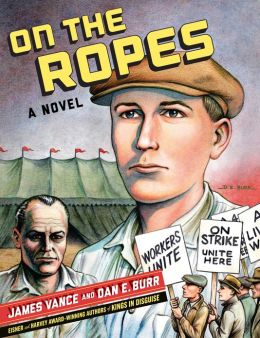- Comics
- Comics Reviews
- Manga
- Comics Reviews
- European Comics
- News
- Comics News
- Press Releases
- Columns
- Spotlight
- Digital Comics
- Webcomics
- Cult Favorite
- Back Issues
- Webcomics
- Movies
- Toys
- Store
- More
- About
By Leroy Douresseaux
March 26, 2013 - 16:50
 |
| On the Ropes cover image is courtesy of barnesandnoble.com. |
On the Ropes: A Novel is a 2013 hardcover, original graphic novel from writer James Vance and artist Dan E. Burr. It is the follow-up to Vance and Burr’s Kings in Disguise, a graphic novel that was originally serialized as a six-issue comic book miniseries and published in 1988 by Kitchen Sink Press.
Kings in Disguise was a highly acclaimed comic book. At the time of its first publication, it drew praise from such comic book luminaries as Alan Moore, Will Eisner, Harvey Kurtzman and Art Spiegelman. It won a Harvey Award and two Eisner Awards.
Set during the Great Depression, Kings in Disguise was the story of 13-year-old Manfred “Freddie” Bloch, a Jewish boy from the fictional town of Marian, California. Freddie and his older brother, Al, are abandoned by their father, a widower who can no longer support his family. In 1932, Freddie takes to the rails – traveling the country by train as a hobo – where he meets Sammy. Calling himself “the King of Spain,” Sammy is a sickly, older hobo who takes Freddie under his wing. Together, they travel through a scarred America, searching for Freddie's father.
On the Ropes opens in 1937, some five years after Freddie Bloch left home. Now 17, Freddie works in a traveling WPA circus. He is apprenticed to the circus’ star attraction, the escape artist, Gordon Corey. The act, called “Gordon Corey Escapes,” is a hangman’s illusion that plays it dangerously close to the edge.
After surviving the Detroit labor riots and violent anti-Communist mobs, Freddie has found home and has even befriended Eileen Finnerty, a gracious young woman who works at the circus. Could she become Freddie’s girlfriend? Before he started working for the circus, Freddie discovered that he has a talent for writing. Thus, he finds a kindred spirit, of sorts, in Barbara Woodruff, a WPA guide book writer who is interested in Gordon’s life story. In her own acerbic way, Woodruff nurtures Freddie’s talent.
Freddie also has a double life. He has joined the Workers Brigade, and he moonlights as a delivery boy for the different groups of workers trying to secretly coordinate their countrywide strikes. As “Jim Nolan,” Freddie receives and sends out secret letters as he travels with the circus. Freddie does not know that Virgil and Chase, two murderous union busters, are trying to find out who the “mailman” is.
Gordon sees that Freddie is playing a dangerous game, and although he is jaded and tired, Gordon wants to see his young assistant make something of himself. Both Freddie and Gordon, however, are haunted by the tragic past, which causes friction between the two. Each man can save the other or bring about their mutual destruction.
I will certainly be among the many reviewers and critics voicing great praise for On the Ropes. In the last decade or so, I have read few comic books that I felt in my heart as I read them. On the Ropes is one of those books. By the end of the year, On the Ropes will likely still be the best comic book or graphic novel of 2013; it will take a miracle for there to be a comic book that knocks On the Ropes off its perch.
James Vance’s story is unflinchingly human, telling a story that captures humankind both in stark contrasts and in perplexing shades of gray. The characters are basically stock characters, but Vance imbues them with humanity. Combine that with the intricacies of the narrative and with the various plot twists and these characters are largely unknowable, but have intriguing quantities that make them worth the effort to know. Vance delves so deeply into plot, setting, and character that his comic book script is more like a novel than a comic book script.
Dan E. Burr’s art is so earnest and heartfelt that it wrings the humanity out of Vance’s story. His compositions are painterly and reminded me of American art movements like American regionalism, social realism, and the Ashcan School. Thus, Burr’s graphical storytelling has more than twice the narrative heft than many of the best graphic novels of the last 30 years.
On the Ropes has a straightforward plot, and past and present are seamless in the way they move the story towards its conclusion. There is such complexity in this graphic novel that the entire time I read it, I thought of On the Ropes as a novel and not as a comic book (not saying comic books are junk).
Of course, the title, On the Ropes, is both literal and figurative. Vance and Burr take on the social and political turmoil of the Great Depression in ways that are intensely poignant and heartrending, but also ardently involved. Vance and Burr aren’t sitting on the sidelines, being dispassionate in recounting the past.
They have turned American history into great drama. This is a hypnotic account of who we were and where we came from that shows us who we are now and why we are where we are. As the Rev. Dr. Martin Luther King said, time is neutral. Then, On the Ropes is not only a timeless masterpiece, but it is also quite timely, especially if you’ve been paying attention to where we are now.
Rating: 10 /10